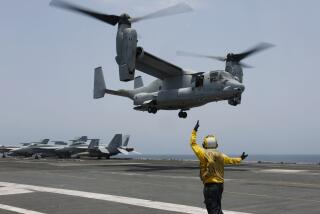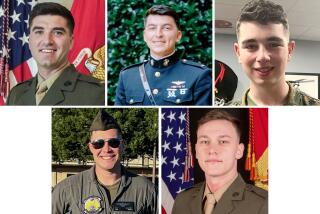House Committee to Examine Military Air Crashes
WASHINGTON — The House Armed Services Committee, alarmed by air crashes both overseas and at home, plans to hear testimony next week on problems with the Marine Corps Harrier attack jet and other aging aircraft.
Though overall military aviation safety has improved during the last decade, the number of major accidents is on the rise, committee members said. For instance, 57 aircraft were destroyed in 2002 -- more than double the previous year -- killing 61 pilots and passengers. The equipment loss totaled more than $1 billion.
The military measures aviation safety by examining the number of “Class A” accidents, those resulting in death or serious injury or at least $1 million in damage, per 100,000 flight hours.
“We’re concerned about a linkage between aging aircraft and aviation safety Class A mishap rates,” said Harald Stavenas, an aide to Rep. Duncan Hunter (R-El Cajon), chairman of the panel.
No single accident sparked the committee’s interest, Stavenas said. But Hunter, who is traveling in Iraq and was unavailable for comment, has expressed concern recently about a string of Harrier crashes in 2003.
The single-seat plane -- which has been in service since 1971 -- crashed five times within eight months last year, with two of the accidents coming during a five-day stretch in December. In each case, the pilots were able to eject safely, but four of the five planes were destroyed. The losses totaled $154 million.
A series of stories in The Times in December 2002 chronicled the Harrier’s record as the military’s most dangerous plane. At that point, the so-called jump jet -- which can lift off vertically like a helicopter, hover in midair and then zip off into conventional flight -- had crashed 143 times and killed 45 Marines.
After the stories were published, Hunter pledged to hold hearings examining the plane’s recurring mechanical and maintenance problems, as well as training for pilots and maintenance workers. He backed away after Marine Corps leaders reassured him they were rectifying the Harrier’s problems and the fleet went the first three months of 2003 without a major accident.
Then came the five crashes, the most for the Harrier in any one year since 1999.
“It obviously doesn’t look like things are getting better,” said Rep. Howard P. “Buck” McKeon (R-Santa Clarita), a committee member.”After all the attention, there’s definitely got to be something wrong there.”
The causes of last year’s accidents have not been disclosed.
The Armed Services Committee has not conducted hearings on aviation safety since 1996. But Hunter long has held that the Pentagon budget is insufficient to replace aircraft and other machinery at an adequate rate.
Stavenas said Wednesday’s hearing would review mishap rates for each branch of the military and for specific aircraft with above-normal accident rates. The committee will hear from top safety or aviation officials from each of the four services, as well as from Christopher Bolkcom, a military aviation analyst with the Congressional Research Service, a nonpartisan agency administered by the Library of Congress.
Sack reported from Atlanta and Miller from Washington.
More to Read
Sign up for Essential California
The most important California stories and recommendations in your inbox every morning.
You may occasionally receive promotional content from the Los Angeles Times.










